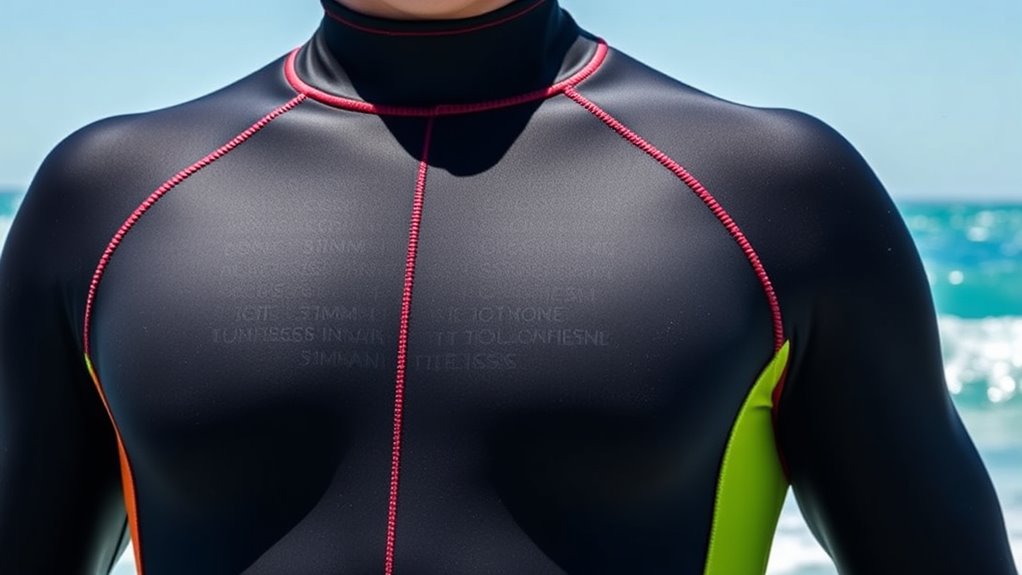To choose the right wetsuit thickness, match it to your water temperature: for cold waters below 60°F, go for thicker suits (5mm+), and for warmer waters above 75°F, opt for thinner or no wetsuit. Consider your body size, cold tolerance, and activity level to guarantee a snug, comfortable fit that keeps you warm without restricting movement. Keep in mind, trying on your wetsuit and evaluating flexibility helps. If you continue exploring, you’ll find more details for your ideal choice.
Key Takeaways
- Match wetsuit thickness to water temperature: thinner for warm waters, thicker for cold climates.
- Use temperature brackets (e.g., 3/2mm, 5/4mm) as guidelines for appropriate suit choices.
- Consider personal tolerance and activity level to select optimal insulation and flexibility.
- Test the wetsuit in water to ensure proper fit, warmth, and mobility before purchasing.
- Add accessories like gloves, hoods, or booties for additional warmth in very cold water conditions.
Understanding Water Temperature Ranges for Water Activities
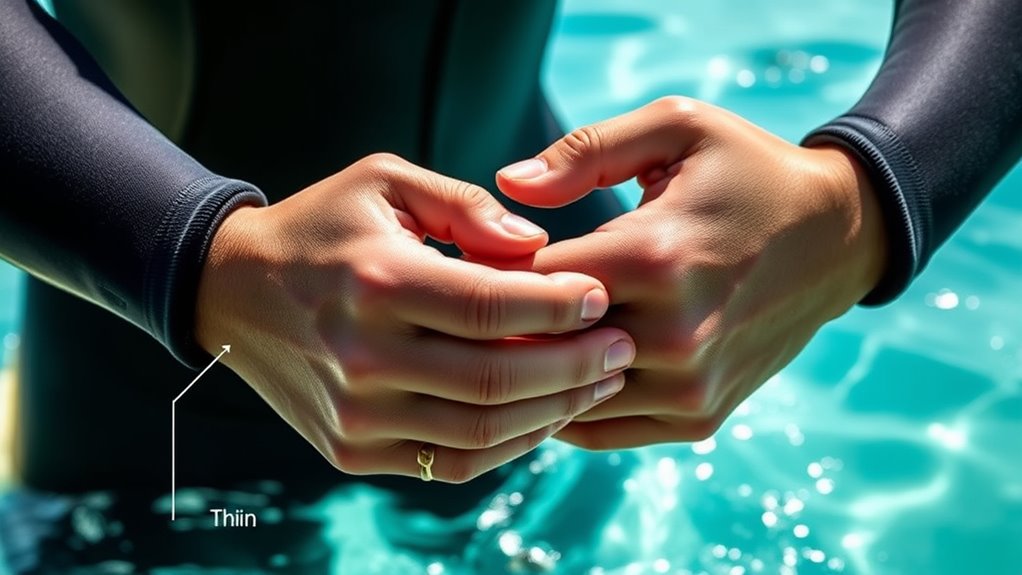
Understanding water temperature ranges is essential when choosing the right wetsuit because it directly affects your comfort and safety during water activities. Knowing these ranges helps you decide whether a wetsuit is needed and what thickness suits best. Cold water, typically below 60°F (15°C), requires thicker wetsuits to retain body heat, and being aware of insulation needs can prevent hypothermia. Temperate waters, between 60-75°F (15-24°C), often call for medium thickness suits. Warmer waters, above 75°F (24°C), might only need a thinner or even no wetsuit at all. Recognizing these temperature brackets ensures you don’t overheat or get too cold, both of which can ruin your experience or cause health issues. Always check current water temperatures before heading out, as they can fluctuate based on location and season. Being aware of water temperature ranges is crucial for selecting the appropriate wetsuit thickness to ensure optimal comfort and safety. Additionally, understanding climate variations and local weather patterns can help you anticipate temperature changes and prepare accordingly. Incorporating knowledge of industry transformations, such as advances in wetsuit materials, can also enhance your selection process and overall water activity experience.
The Importance of Wetsuit Thickness in Different Climates
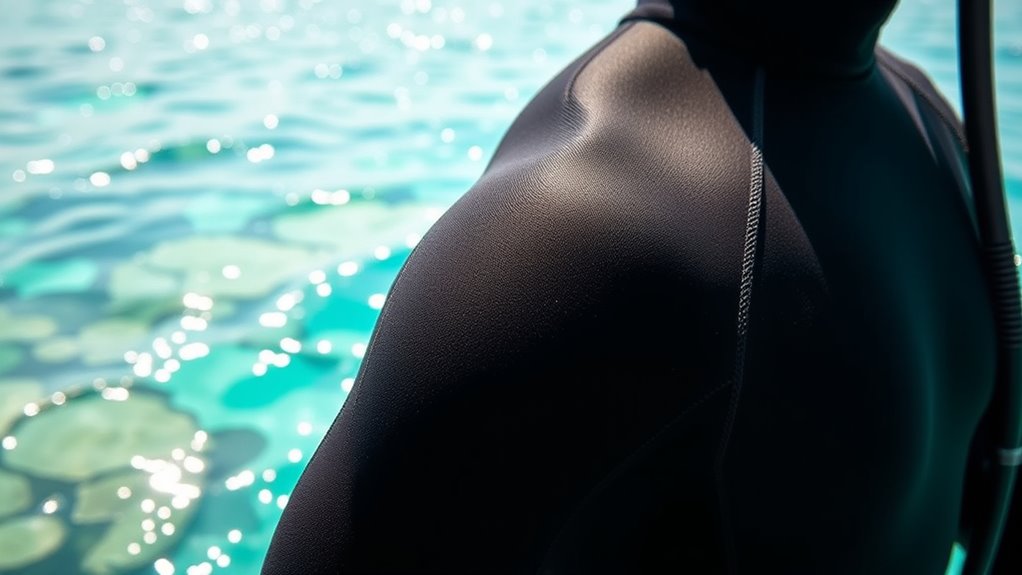
Wetsuit thickness plays a essential role in adapting to different climates, ensuring you stay comfortable and protected regardless of where you surf or dive. In colder climates, thicker wetsuits—typically 5mm or more—provide insulation, preventing heat loss and maintaining your core temperature. Conversely, in warmer regions, thinner suits like 2mm or 3mm allow for greater flexibility and breathability, helping you stay cool. The right thickness depends on the water temperature and climate conditions, so choosing appropriately prevents hypothermia or overheating. This balance is indispensable to enjoying your water activities without discomfort or health risks. By understanding how climate impacts water temperature, you can select a wetsuit that offers prime insulation and freedom of movement, making your experience safer and more enjoyable. Additionally, considering the types of wetsuit materials can enhance your comfort and performance in various water conditions. Properly selecting the right wetsuit thickness also involves understanding the design features that improve thermal efficiency and durability. Knowing how proper fit influences warmth and mobility can further optimize your wetsuit choice for different environments. Recognizing the relationship between water temp and wetsuit thickness can help you make more informed decisions to stay comfortable in diverse conditions.
How Body Size and Tolerance Affect Wetsuit Choice
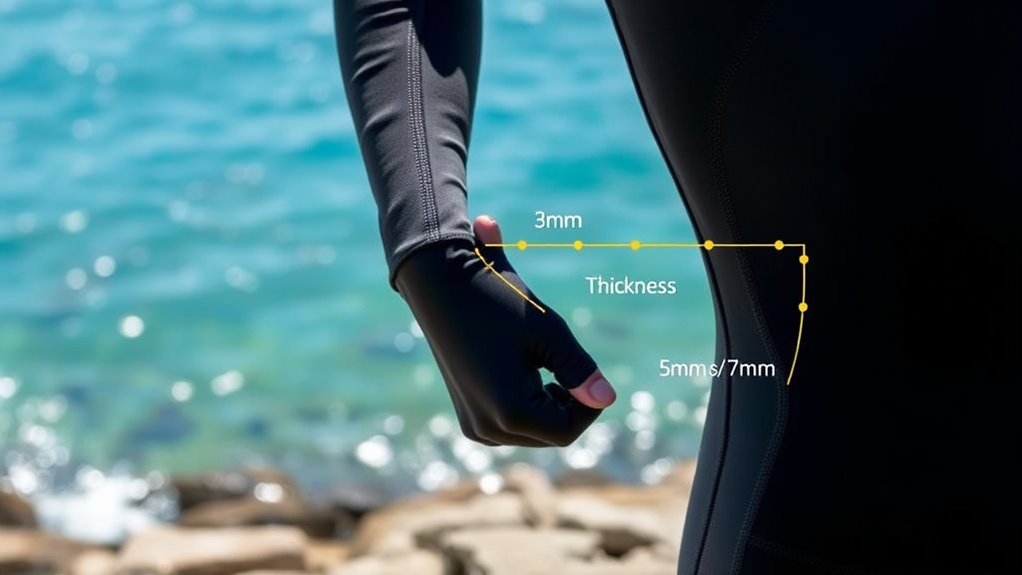
Your body size and personal tolerance considerably influence the ideal wetsuit choice because they directly affect how well the suit fits and how comfortable you’ll feel in the water. If you’re taller or have a broader build, a suit with a slightly thicker or more flexible material might be necessary to ensure proper insulation and mobility. Conversely, smaller or more petite individuals may prefer a snug fit to minimize water entry and maximize warmth. Personal tolerance to cold varies, so if you’re more sensitive, opt for a suit that offers extra insulation or a tighter fit to retain heat. Remember, a well-fitting wetsuit enhances warmth, comfort, and performance, so consider your body shape and how you react to cold when choosing thickness. Additionally, understanding wetsuit material properties can help you select a suit that balances flexibility and insulation effectively, especially in relation to thermal protection levels. Recognizing how wetsuit thickness impacts insulation can also guide you in making the best choice for different water temperatures. Moreover, selecting a suit with appropriate size and fit is crucial to prevent water flushing and ensure optimal thermal retention.
Common Wetsuit Thicknesses and Their Suitable Conditions
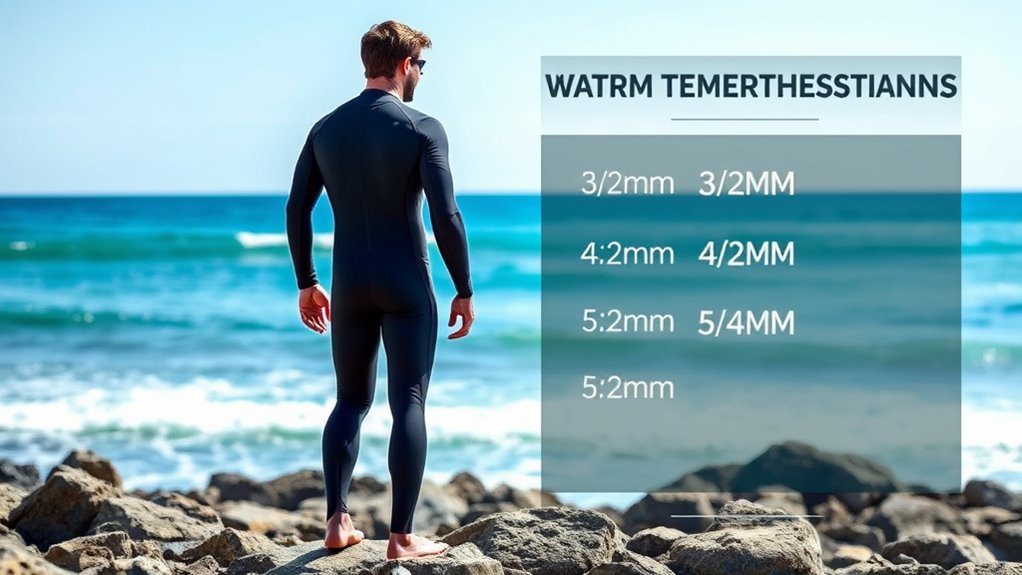
Different wetsuit thicknesses are designed for specific water temperatures and activity levels, helping you stay comfortable and warm without overheating. A 3/2mm wetsuit is versatile, suitable for water temperatures around 60-70°F, ideal for recreational surfing or diving. Thicker options like 4/3mm or 5/4mm provide extra insulation, perfect for colder waters between 50-60°F, such as winter surfing or cold-water diving. For very cold conditions below 50°F, a 6/5mm or even 7mm wetsuit offers maximum warmth, often with added features like thermal lining or hood. Thinner suits, like 2mm, are best for warmer waters above 70°F, such as summer swimming or snorkeling. Additionally, selecting the appropriate wetsuit thickness can improve your overall water experience and safety. Choosing the right thickness guarantees you stay comfortable and safe during your water activities. Proper wetsuit fit is also crucial to prevent water from seeping in and reducing insulation effectiveness. Being aware of water temperature ranges helps you make more informed choices for your wetsuit. Moreover, understanding the different wetsuit materials can help you select suits with better flexibility and durability for your specific needs.
Tips for Trying on and Testing Your Wetsuit
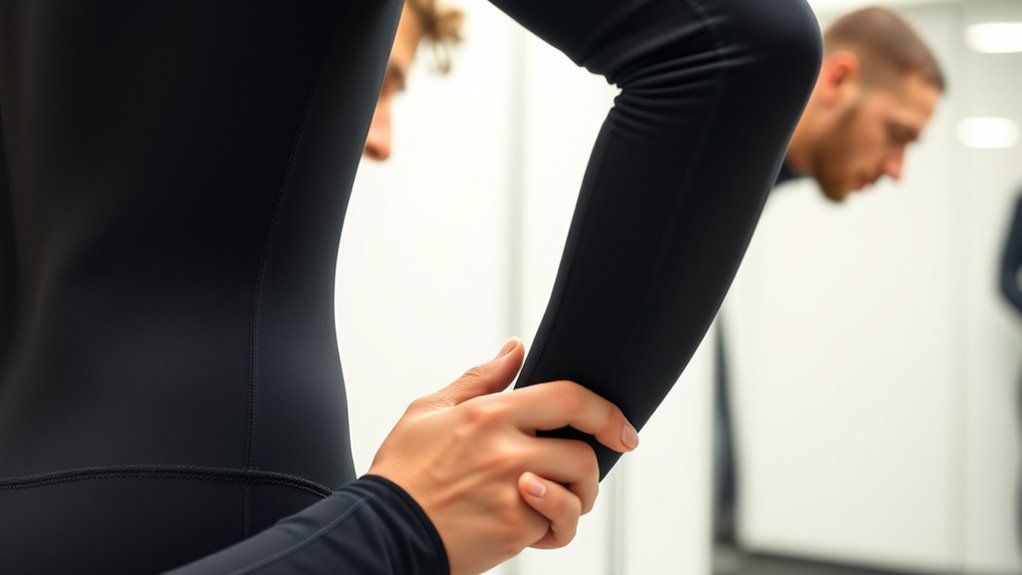
When trying on a wetsuit, make sure it fits snugly without restricting your movement or breathing. Move around and stretch to see if it stays comfortable and flexible. Whenever possible, test it in water to confirm it keeps you warm and allows easy movement. Additionally, consider how the wetsuit’s fit and flexibility can impact your safety and overall experience in different water temperatures. Incorporating AI-driven analysis can also help you select the appropriate thickness by evaluating your activity level and water conditions. Recognizing the importance of proper cheating prevention strategies can ensure a trustworthy and enjoyable water activity experience. Understanding the self-watering plant pots system can serve as a metaphor for ensuring your wetsuit maintains optimal moisture retention and comfort during use, similar to how wireless headphone connectivity relies on proper pairing for optimal performance.
Check Fit Properly
To guarantee your wetsuit fits correctly, it’s essential to try it on and move around in it before making a purchase. Ensure it hugs your body without feeling too tight or restrictive. Check that the suit’s seams lie flat against your skin and don’t cause discomfort or chafing. Bend your arms and legs to test flexibility; a good fit should allow natural movement without bunching or pinching. Pull gently at the shoulders and waist to see if the suit shifts or gaps. Make sure the zipper zips smoothly without strain. Sit, squat, and stretch to observe how the wetsuit responds. A proper fit provides insulation and comfort, setting the foundation for a successful water experience. Incorporating professional equipment during fittings can also help assess the suit’s performance and durability. Additionally, understanding narcissistic traits in others can be useful when considering the behavior of sales staff or fellow shoppers during your purchase process. Remember that proper fit enhances not only comfort but also your overall safety and enjoyment in the water. When trying on wetsuits, using a quality fitting room mirror can help you better evaluate how well it conforms to your body shape.
Move and Breathe Freely
Ensuring you can move and breathe comfortably is essential when trying on a wetsuit. First, don’t force yourself into a suit that feels too tight or restrictive. You should be able to stretch your arms, bend your knees, and take full breaths without feeling compressed. Pay attention to any pinching or tight spots, especially around your shoulders, chest, and neck. A well-fitting wetsuit allows natural movement without sacrificing insulation. When trying it on, breathe deeply and move around to test flexibility. If you feel restricted or uncomfortable, it’s a sign the wetsuit isn’t the right size or thickness. Comfort and mobility are key to staying warm and enjoying your water activities without distraction or fatigue.
Test in Water
Trying on your wetsuit in the water is the best way to guarantee it fits properly and performs as expected. When you’re in the water, pay close attention to how it feels around your shoulders, chest, and hips. Move your arms and legs to see if it restricts your motion or causes discomfort. Check for any gaps or loose areas, especially around the wrists, ankles, and neck. Make sure it stays snug without feeling constrictive. If possible, swim a few strokes or practice breathing to test mobility and buoyancy. Remember, a wetsuit should feel like a second skin—tight enough to insulate but flexible enough for natural movement. Testing in water ensures you get the right fit for comfort and thermal protection.
Additional Gear and Accessories for Cold Water Protection

To stay warm in cold water, consider adding gear like neoprene gloves and booties to protect your extremities. A waterproof hood can also make a big difference in retaining heat. Additionally, sealant and tape are handy for fixing any wetsuit tears or leaks that might compromise your insulation.
Neoprene Gloves and Booties
Neoprene gloves and booties are essential accessories that provide extra warmth and protection in cold water conditions. They help prevent heat loss through your hands and feet, which are vulnerable areas during water activities. Gloves keep your fingers flexible while maintaining insulation, making paddling or handling equipment easier. Booties, on the other hand, fit over your feet and can be worn with fins or barefoot, offering additional warmth and grip. Choose thickness based on water temperature—generally, 3mm gloves and booties suit cooler waters, while 5mm or thicker are better for very cold conditions. Make certain a snug fit; loose gear can let in cold water and reduce effectiveness. Properly fitted neoprene accessories make a significant difference in staying comfortable and safe in cold environments.
Waterproof Hood Options
When venturing into cold water, a waterproof hood can substantially enhance your insulation and comfort. It helps retain heat that would otherwise escape from your head, which is a major heat loss area. Waterproof hoods come in various styles, from simple neoprene caps to full-face designs with sealed seams. Choose a hood that fits snugly without restricting movement or breathing. Look for features like adjustable closures or elastic edges to ensure a secure fit. Some hoods include built-in visors or face shields for added protection against wind and spray. Wearing a waterproof hood with your wetsuit maintains body warmth, reduces fatigue, and lets you stay in the water longer. Proper selection of a hood is essential for cold water immersion, especially in lower temperature ranges.
Sealant and Tape Use
Applying sealant and tape is essential for maintaining the integrity of your wetsuit and other gear in cold water. Over time, seams can develop leaks, compromising warmth and safety. Sealant acts as a waterproof barrier, sealing small gaps and reinforcing weak spots. Tape, especially neoprene or waterproof repair tape, provides a quick fix for tears or worn areas. Before applying, ensure surfaces are clean and dry. Use sealant sparingly, focusing on seams and potential leak points. Tape should be firmly pressed down to eliminate air bubbles and ensure a strong bond. Regularly inspecting and maintaining your gear with sealant and tape helps extend its lifespan and keeps you warm and dry during cold water adventures. Proper use of these accessories is a simple yet vital step in cold water protection.
Frequently Asked Questions
How Often Should I Replace My Wetsuit for Optimal Insulation?
You should replace your wetsuit when it no longer provides proper insulation or shows significant signs of wear. Over time, material degrades, reducing its effectiveness. Typically, consider replacing it every 1 to 3 years, depending on usage and care. Regularly inspect for tears, thinning fabric, or loose seams. If you notice less warmth or water leaks, it’s time for a new wetsuit to keep you comfortable and protected in the water.
Can Layering Wetsuits Improve Warmth in Extremely Cold Water?
Layering wetsuits can definitely boost your warmth in extremely cold water. You can wear a thinner wetsuit underneath a thicker one, creating added insulation without sacrificing mobility. Just make sure the layers fit well to avoid gaps that let in cold water. Using a wetsuit liner or thermal rash guard can also help retain heat. This approach is effective, especially when you need extra protection in freezing conditions.
What Are the Signs That My Wetsuit Is No Longer Effective?
Did you know that a wetsuit’s effectiveness drops considerably once it loses its flexibility? If you notice your wetsuit feels loose, water rushing in, or it no longer keeps you warm, it’s a sign it’s no longer effective. You might also feel increased fatigue or coldness sooner. When these signs appear, it’s time to replace or repair your wetsuit to stay warm and safe in the water.
How Does Water Temperature Fluctuate During Different Seasons?
You’ll notice water temperature varies throughout the year, often warmer in summer and colder in winter. During spring and fall, temperatures can fluctuate daily due to weather changes. You might feel warmer or cooler at different times, so it’s important to check local water conditions regularly. Staying aware helps you decide when to wear a wetsuit, ensuring comfort and safety during your water activities.
Are There Specific Wetsuit Materials Better for Certain Water Temps?
You’ll find that different wetsuit materials suit various water temps better. For colder waters, neoprene with high-density foam offers better insulation, keeping you warm longer. In milder conditions, flexible materials like softer neoprene or thinner suits provide comfort and mobility. You should pick a material based on how cold or warm the water is, ensuring you stay comfortable and safe during your water activities.
Conclusion
Choosing the right wetsuit is like finding the perfect armor for your aquatic adventures. When you pick the right thickness, you’ll glide through water like a fish in its element, confident and comfortable. Don’t let the chill catch you off guard—think of your wetsuit as a second skin, tailored to keep you warm and agile. plunge in prepared, and let your water experiences be as smooth and effortless as a gentle current.

